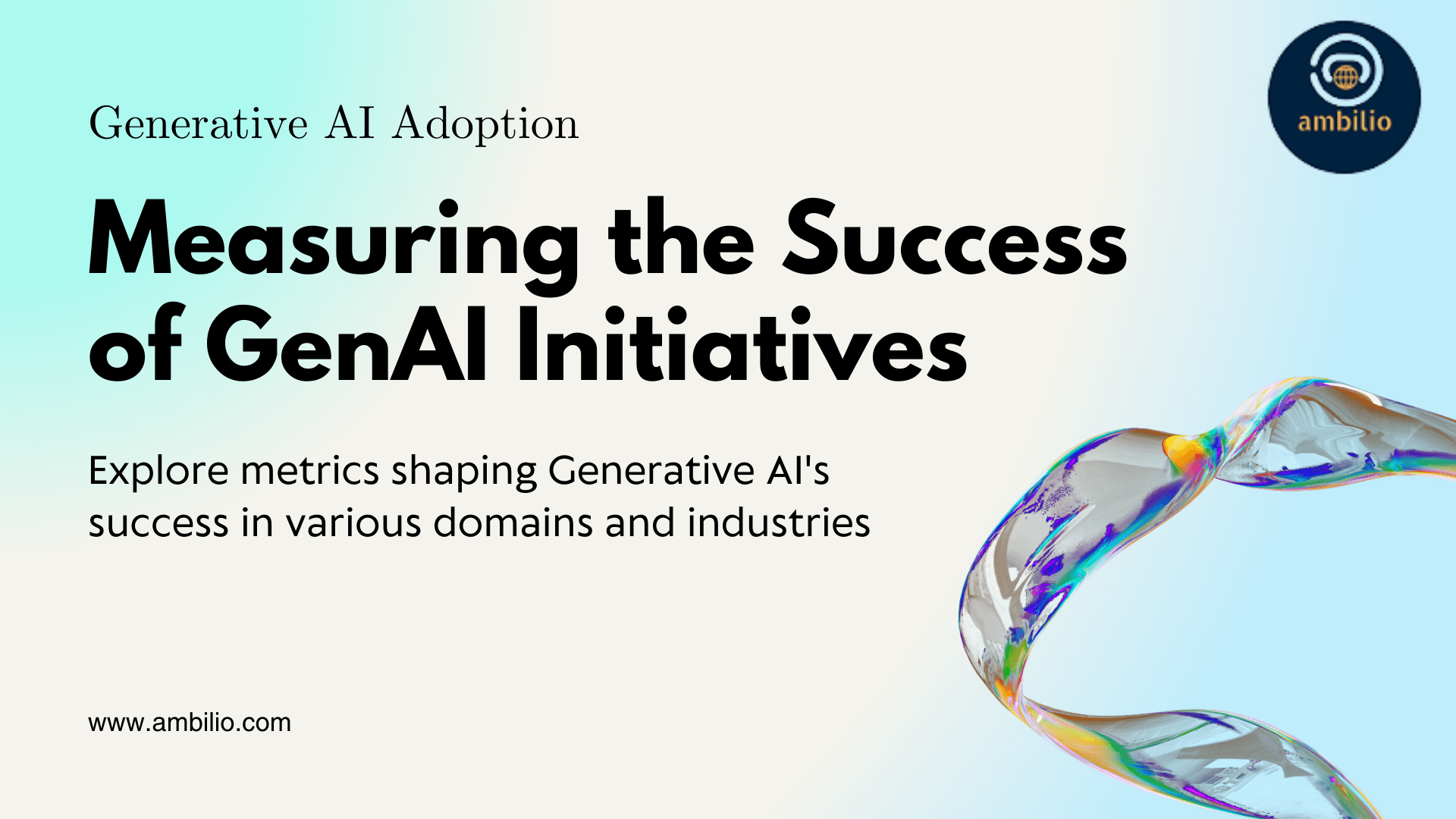In the ever-evolving landscape of artificial intelligence, generative AI stands as a beacon of innovation, pushing the boundaries of creativity and problem-solving. From generating art and music to crafting human-like text, generative AI has become increasingly prevalent across various industries. However, as organizations invest resources into these initiatives, the pressing question arises: how do we measure their success? Measuring the success of generative AI initiatives entails navigating a nuanced landscape, where traditional metrics may fall short in capturing the essence of creativity and innovation.
In this article, we delve into the intricacies of evaluating the effectiveness of generative AI projects, exploring the key metrics and methodologies that enable organizations to gauge their impact.
Defining Success in Generative AI Initiatives
Before embarking on the journey to measure the success of generative AI initiatives, it is essential to peel back the layers and understand the nuanced dimensions that define success in this context. Unlike the straightforward objectives of traditional AI applications, which often revolve around optimizing specific tasks, the realm of generative AI introduces a rich tapestry of subjective qualities, where success is not easily quantifiable but rather felt in the depths of creativity, originality, and the human-like essence of the generated output.
Success in generative AI is a multifaceted gem, catching the light from various angles, each revealing a different facet:
- Quality of Output: This facet of success delves into the very essence of the generated content, probing its fidelity, coherence, and relevance to the intended purpose. It’s not merely about producing content; it’s about producing content that resonates, content that speaks its purpose eloquently, whether it’s a piece of literature, an image, or a musical composition.
- Engagement: Beyond the mere creation of content lies its reception by an audience. Here, success is measured by the level of engagement stirred by the generated material. It’s about eliciting not just passive observation but active interaction, sparking interest, and evoking emotional responses that captivate and enthrall.
- Novelty: In the sea of data swirling around us, success in generative AI is marked by the ability to navigate through the currents of repetition and emerge with something truly original. Novelty is the hallmark of success, where the generated content stands as a testament to innovation, avoiding the trappings of replication and breathing fresh life into the creative landscape.
- Utility: While creativity and novelty are undoubtedly vital, the success of generative AI initiatives is ultimately anchored in their practical value and applicability in real-world scenarios. It’s about bridging the gap between imagination and utility, ensuring that the generated outputs are not just ephemeral expressions but tangible assets capable of driving meaningful impact and solving real-world problems.
Each of these facets intertwines to form the intricate fabric of success in generative AI initiatives. It’s not a singular destination but a journey through the depths of creativity, engagement, innovation, and utility, where success is not measured in absolutes but in the delicate balance struck between these myriad elements.
As organizations navigate this terrain, they must adopt a holistic perspective, recognizing that success cannot be distilled into a single metric or parameter. Instead, it requires a nuanced understanding of the interplay between technical prowess, human perception, and real-world impact. By embracing this complexity and approaching the measurement of success with humility and curiosity, organizations can unlock the full potential of generative AI and harness its transformative power to shape a future where creativity knows no bounds.
Quantitative Metrics for Evaluation
While the subjective nature of generative AI poses challenges, incorporating quantitative metrics provides a structured approach to evaluation while measuring the success of Generative AI initiatives. These metrics offer insights into the performance and impact of AI models, facilitating informed decision-making. Some key quantitative metrics include:
- Perplexity: Commonly used in natural language processing tasks, perplexity measures the predictability of generated text. Lower perplexity scores indicate greater coherence and fluency in language generation.
- Fidelity: Quantifying the similarity between generated content and human-authored examples using techniques like cosine similarity or BLEU (Bilingual Evaluation Understudy).
- Convergence Speed: Assessing how quickly a generative AI model converges to optimal performance during training. Faster convergence often indicates efficient learning and model effectiveness.
- Diversity: Measuring the variety and richness of generated outputs, ensuring the avoidance of repetitive or biased content generation.
- Scalability: Evaluating the efficiency of AI models in handling increasing volumes of data and computational resources, crucial for real-world deployment.
Qualitative Assessment and Human Evaluation
While quantitative metrics provide valuable insights, they often fall short in capturing the nuanced aspects of generative AI output. Qualitative assessment, complemented by human evaluation, adds depth to the evaluation process. Techniques such as expert reviews, user surveys, and crowdsourced annotations enable subjective evaluation of generative AI outputs based on criteria such as:
- Creativity: Assessing the originality, novelty, and artistic merit of generated content, often requiring human judgment and domain expertise.
- Emotional Impact: Gauging the emotional resonance and authenticity of generated material, capturing its ability to evoke feelings and connect with the audience.
- Ethical Considerations: Evaluating the ethical implications of generated content, including issues related to bias, fairness, and societal impact.
Real-World Application and Business Impact
As generative AI initiatives move beyond theoretical concepts and enter real-world implementations, their success extends beyond technical achievements. Evaluating their application and impact involves considering factors such as user adoption, market differentiation, cost efficiency, and social good.
- User Adoption: The success of generative AI depends on how well users embrace and benefit from AI-powered products and services. High adoption rates and user satisfaction indicate that these solutions meet user needs effectively. Whether it’s a chatbot assisting customers or an AI-generated design tool aiding creatives, user adoption metrics reflect the utility and value proposition of generative AI.
- Market Differentiation: In competitive markets, generative AI can help organizations stand out by offering innovative solutions that resonate with consumers. Success in this area is measured by the degree of differentiation achieved through generative AI implementations. Whether it’s through personalized experiences or novel customer engagement approaches, generative AI can drive customer loyalty and market leadership.
- Cost Efficiency: While cutting-edge technology is attractive, its practicality depends on cost efficiency. Evaluating the cost-effectiveness of generative AI involves analyzing factors such as infrastructure costs and return on investment. Success here means delivering value while optimizing resources, ensuring that the benefits of generative AI outweigh its costs.
- Social Good: Generative AI can also contribute to societal benefits by fostering inclusivity, diversity, and creativity. Success in this aspect is measured by the positive impact on society, such as facilitating accessibility or advancing creative expression.
By considering these factors, organizations can assess the real-world application and business impact of generative AI initiatives effectively.
Final Words
Measuring the success of generative AI initiatives requires a nuanced approach that combines quantitative metrics, qualitative assessment, and real-world impact evaluation. By leveraging a diverse set of evaluation methodologies, organizations can gain comprehensive insights into the performance, effectiveness, and societal implications of generative AI projects. As the field continues to evolve, refining these evaluation frameworks will be crucial in unlocking the full potential of generative AI across various domains.



